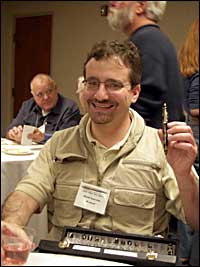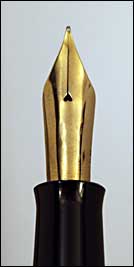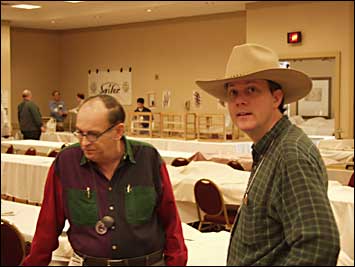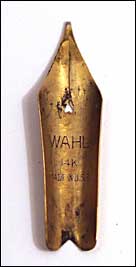|
One of the oldest and best vintage shows, the Ohio Pen Show features a great helping of modern pens as well. What I do at shows, at least the part that pays the bills, doesn’t differentiate between modern and vintage, so I just look upon Columbus as a great place to be for a November weekend. And what a weekend it was! Here’s a 180° view of the ballroom as seen from my table on Sunday afternoon:
What you see above is almost all vintage. There’s the Bexley/Sailor table at the extreme left, Steve and Maryann Zucker of PenstopOnline are hiding about midway down along the left wall, and way down in the far left corner is the Total Office Products table where Jimmy Dolive and Pentracer Mort Epstein were plying their trade. So where were the rest of the new-pen folks? Out in the corridor that runs along two sides of the ballroom, sharing space with yet more vintage dealers!
  The guy in the khaki shirt and jeans, walking toward the camera, is the redoubtable John Mottishaw, who delivered a seminar on the makings of the perfect nib on Sunday. But this is only half of the corridor; I didn’t have enough electronic “film” to take a picture of the other half on Sunday afternoon. (I did shoot it on Friday morning, as people were getting set up, but it was really boring.) The guy in the khaki shirt and jeans, walking toward the camera, is the redoubtable John Mottishaw, who delivered a seminar on the makings of the perfect nib on Sunday. But this is only half of the corridor; I didn’t have enough electronic “film” to take a picture of the other half on Sunday afternoon. (I did shoot it on Friday morning, as people were getting set up, but it was really boring.)
 The show really started on Thursday, with a wine and cheese party for the exhibitors and weekend traders. First to float into the camera’s view was Joel Hamilton, half of the brother/sister tag team called Inkpen.com. I don’t remember what he was laughing at; maybe it was Terry Clark, who was sitting immediately to his left, just outside the right edge of this picture, busily snapping pictures. It was a great party; Terry and Sonya Mawhorter, the organizers, put on a really good show, and they do so much to make everyone comfortable so we can just all have a good time. Friday’s good time was a pizza party courtesy of Pendemonium. followed by the annual PCA meeting (with door prizes including a bottle of DC SuperShow Blue, a Sheaffer Fashion set, a Ronson ballpoint that is now the property of Barbara Hauck Binder, and more). Saturday’s good time was dessert, followed by the auction. All but about two auction lots sold, thanks to the indefatigable zaniness of Craig Bozorth, and the two that didn’t go had reserves on them. The show really started on Thursday, with a wine and cheese party for the exhibitors and weekend traders. First to float into the camera’s view was Joel Hamilton, half of the brother/sister tag team called Inkpen.com. I don’t remember what he was laughing at; maybe it was Terry Clark, who was sitting immediately to his left, just outside the right edge of this picture, busily snapping pictures. It was a great party; Terry and Sonya Mawhorter, the organizers, put on a really good show, and they do so much to make everyone comfortable so we can just all have a good time. Friday’s good time was a pizza party courtesy of Pendemonium. followed by the annual PCA meeting (with door prizes including a bottle of DC SuperShow Blue, a Sheaffer Fashion set, a Ronson ballpoint that is now the property of Barbara Hauck Binder, and more). Saturday’s good time was dessert, followed by the auction. All but about two auction lots sold, thanks to the indefatigable zaniness of Craig Bozorth, and the two that didn’t go had reserves on them.
  Rewind to Thursday. Not too much later, David Isaacson, the Vacumaniac, pulled up a chair and whipped open a case to show off his latest acquisition. Surprisingly, it wasn’t a Vac. It wasn’t even a Parker! No, what the good doctor had managed to nail down was a near-mint Oversize Pearl and Black Lifetime Sheaffer’s Balance that was probably made in 1929. Or maybe 1930. David was ecstatic. Of course, he also had a case of his prize Vacs with him, with some new additions since the last time I saw him, and I oohed and ahhed over them. I wanted most of them, but I was coolly informed that these pens were not for sale. Drat. And in the case with that Sheaffer were some other dandy pieces, too, among them a to-die-for jade Chilton Second Model with perfect (yes, perfect) color. Rewind to Thursday. Not too much later, David Isaacson, the Vacumaniac, pulled up a chair and whipped open a case to show off his latest acquisition. Surprisingly, it wasn’t a Vac. It wasn’t even a Parker! No, what the good doctor had managed to nail down was a near-mint Oversize Pearl and Black Lifetime Sheaffer’s Balance that was probably made in 1929. Or maybe 1930. David was ecstatic. Of course, he also had a case of his prize Vacs with him, with some new additions since the last time I saw him, and I oohed and ahhed over them. I wanted most of them, but I was coolly informed that these pens were not for sale. Drat. And in the case with that Sheaffer were some other dandy pieces, too, among them a to-die-for jade Chilton Second Model with perfect (yes, perfect) color.
By the time the party was over, the trading room was also pretty empty. So the show really got rolling for most of us on Friday morning. As usual, Barbara and I hurried right in and set up. And as usual, there were people pretty much standing on top of us, wanting to help us get our stuff organized, as we did so. We had a steady flow of clients all weekend long, including some interesting challenges such as a Snorkel with an XF nib that just did not want to write smoothly.
There’s always something at a pen show that you’ve never seen before. I found Lynn Brant on Sunday morning and had a delightful chat about pens in general and Skylines in particular. Lynn showed me a few Skylines, lovely pens from his personal collection. I found myself particularly drawn to the one in this photo. It’s not an unusual pen, just a black one with a gold-filled cap, but the nib did get my attention.

So who all was there? Frank Dubiel and Roger Wooten. Regina Martini and Al Mayman.
 |
 |
And too many other people to even begin to count. Sam and Frank (both sort of visible in the panorama at the top of the page). AnnMarie. Lee Chait (who arrived, as usual, sometime last month). Jim Hickman. Tim Pierson. Paul Erano (watch for his new book, due out in the spring). Dan Reppert (more White Dots than you can shake a stick at). Craig Bozorth (auctioneer extraordinaire). Len Provisor. Steve and Maryann Zucker (nice Swan, Maryann, but that's one weird nib!), Dennis and Madelyn Bowden (Parkville Pens). Susan Wirth. Bill Weakley. Rick (the PENguin) Propas. Warren Granek. Bert and Alice Heiserman. Dick Johnson. Chris Thompson. Sherrell Tyree (Joel Hamilton’s sister and partner). Carla Mortensen. Lisa Hanes. Joe Nemecek (Pencils ‘R’ Us). Jimmie Cockburn. Judd Perlson. Dean Tweeddale (who said Bill Riepl was there, but I never saw the gentleman). John Bull (World’s Best Ink Remover). Al Bernhardt. Richard Jarvis. Peter Ford. Howard Levy and Jim Barclay. Mike Masuyama. Dick Egolf. Who else? Oh, man, my memory fails me. This was one great show for seeing friends.
Oh, yes, there was of course our very own Giovanni Abrate, who was likin’ Barbara’s FILCAO Leader with the custom Binder stub...
Okay, back to work now. The right image above shows the busy hands of one of my clients, who was attending his first pen show and was so excited he was almost beside himself. He brought some pens for me to customize, naturally, and in this photo he is testing one of them on several papers he brought along. It’s a good thing he came, as it turned out, because I have one of his other pens (a Conway Stewart Dinkie) in my queue, and by getting to meet him I learned much more about how to tune that pen.
Barbara and I were kept pretty busy all weekend. I did manage to buy one pen, but not on the floor. In the bar (!) on Saturday evening, I got into a discussion with Roger Cromwell, and we rapidly concluded that he had a pen I want. But it was in California. So now I’m awaiting delivery of a near-mint (or maybe mint) boxed Eversharp 64 set.
It’s funny how the best sometimes waits for last. Late Sunday afternoon, a woman who is a professional calligrapher sat down at my table. After a short chat about Bill Lilly, the only known living Gold Seal graduate of the Zanerian College of Penmanship in Columbus (remember Zaner-Bloser pens? That’s where they came from), we got down to serious business. She tried out all of my demonstrators and settled on the 1.1-mm cursive italic. But she wanted a really sharp one, and the 0.9-mm crisp italic was catching on the right corner. So we tried a standard 15° right-foot crisp oblique. That caught on the left corner. I watched her, made a snap judgment, and ground a 1.1-mm 4° oblique. (I ground it extra thin, so it would give about 10:1 line variation.) Left corner still caught. I backed off to 2°. Still catching. More work, to make it 1°, and omigosh, she took off and sailed. That was what she needed. She took the nib and a new M200 away, and we packed up for the day. For the show.
What do you do after a pen show? You go out to eat because you are sick and tired of hotel-restaurant food and what passes in establishments of that type for service. A round dozen of us adjourned to Spain, a restaurant in a different hotel. But Spain is not a hotel restaurant. The service is quick and courteous, the food is plentiful (tapas you can share all around the table, and paellas big enough for two with leftovers) and remarkably good (which means there ain’t a lot of leftovers), and the sangria flows freely. At our table were Barbara and I, Giovanni Abrate, Len Provisor, and Mike and Jean Wascher. At the other table were Lisa Hanes, AnnMarie Houtaniemi (didn’t think I knew how to spell it, did you!), Richard Jarvis, Joe Nemecek, David Isaacson, and Paul Erano.
Post Scriptum
I have to share one more story. This is why I go to pen shows instead of just holing up in my pen studio. On Saturday afternoon, a woman named Pam sat down at my table and pulled out a bag of pens. She said apologetically that they were really nothing (an Esterbrook, a Sheaffer school pen with a semi-hooded nib, and a no-name), but they had turned up in her parents’ things after both had passed on. Could I make them work? I could, and they’re here in the queue now. Last, she held up a sliver of gold-colored metal. A nib. The immediate reaction, Oh, no, this is going to be very sad, quickly gave way to Hmm, this is a Waterman’s ideal Nº 2, and it’s straight, with good iridium and no cracks. And it’s a flex! Pam had found the nib in her mother’s bureau drawer, and she wanted to know if I could find a pen to put it in. Creating a pen ex ungue leonem, as it were, is always an interesting project, so I gave her some direction and sent her in search of a nibless 52. She returned some time later with a $15.00 prize, courtesy of Steve Nagy. I knocked it apart (discovering the back 1/4” of a broken nib as I did so), cleaned it, set the nib and feed, and then sent her to the opposite corner of the room, where Roger Cromwell was doing his usual come one, come all repair business. (I tripped down there first to lay the groundwork.) As we were getting ready to leave the ballroom at the end of the day, we met Pam once more. With a teary-eyed hug, she thanked us for giving her back a pen that, for her, had been her mother’s.
But there’s more. A week or so after the show, I received the following in an email from Pam. I asked her if I might share it because it says a great deal about what fountain pens mean, and what they can do for us as writers:
The 52 is a GREAT pen. It’s been getting a real workout. No one in my address book has escaped a letter recounting the saga of a little pen nib, a wizard named Richard and the magic he spun at a little table in the corner of the pen convention. I think, Richard, that, you gave me two gifts that day. Physically, of course, this incredible pen, but also, you introduced me to the concept (through your great “Cadillac vs Yugo” philosophy) that a pen CAN have its own quality. Before this I always thought that a handwriter only needed ink and nib and it was totally their hand that controlled the line that occurred on the paper. The little 52 has been a revelation. For the first time in my life I realize that handwriting is a partnership between the mind, the heart, the hand and the pen. The feel of this pen in my hand, how it literally rolls and glides and takes hold of my hand, and oh, oh, oh, the beautiful lines and marks we create together — amazing. You’ve opened my eyes, Richard, educated me to the fact that a pen IS a writing instrument with its own integrity, balance, movement. Big, big Thank You!
If that doesn’t make it all worthwhile, I challenge you to show me something better.
Quiz Answer
Oh, in case you haven’t yet figured out what’s so unusual about that Skyline nib, take a close look at the imprint. No, don’t go back up there to do it, look here. At the underside of the nib. Oopsie!

© 2003 Richard F. Binder
|